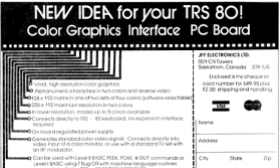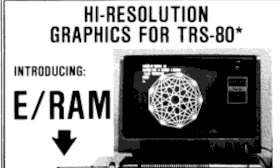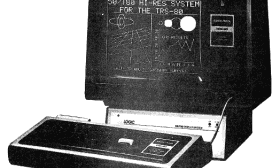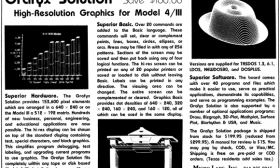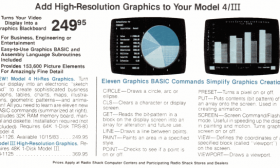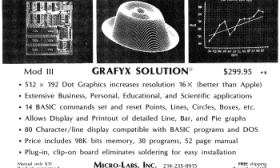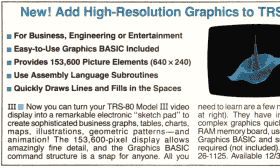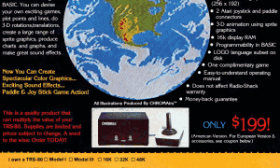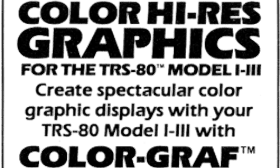Articles in the "Graphics" Category
The Color Graphics Interface from JFF Electronics was one of the first color add-ons for the TRS-80 Model I. It cost $49.95 when it was introduced in early 1979 by JFF Electronics Ltd of Saskatoon, Canada. The Color Graphics Interface didn’t require a Radio Shack Expansion Interface but plugged directly into the Model I 40-pin expansion bus. It didn’t include an enclosure but was a bare circuit board. However, it did include a regulated power supply on the board.
The Color Graphics Interface could be connected to either a color monitor or a color television set. It supported several different modes:
- a text display with two colors and reverse video
- a 64 by 192 mode with eight colors
- a 128 by 192 mode with four colors (in two sets)
- a 256 by 192 mode with two colors
(Read more...)
The E/RAM was a high-resolution add-on for the TRS-80 Model I. Introduced in 1980 for a price of $349.95, the E/RAM was designed and manufactured by Keyline Computer Products from Tulsa, Oklahoma. It was sold by Vern Street Products, also in Tulsa.
The E/RAM (an acronym for Extended Random Access Memory) contained 6K of video memory. It increased the TRS-80 graphics resolution to 256 by 192, with the high-resolution graphics overlaying the text screen. The graphics could be enabled and disabled using either software or a hardware switch.
The E/RAM came in a steel case measuring 2 1/2″ high, 6″ wide, and 12″ deep. The self-contained unit sat next to the Model I and installed in a straightforward way:
(Read more...)
Unlike many competing computers, the TRS-80 Model I lacked any form of built-in high-resolution graphics. Although some TRS-80 compatible computers, such as the LNW80, offered high-resolution as a feature, the only graphics possible with the Model I were relatively low-resolution 128 by 48 block graphics. The many games written for the Model I made good use of these block graphics, and Radio Shack never made high-resolution a standard feature of the Model I, III, or 4. Several companies created products to address this deficiency, with some becoming more popular than others.'
(Read more...)
The SubLOGIC 50/T80 was a high-resolution add-on for the TRS-80 Model I. It was created by SubLOGIC, a company better known to TRS-80 users for their T80-FS1 Flight Simulator.
Here is the text of the 1980 product introduction:
The SubLOGIC 50/T80 system is a high performance professional graphics display system designed to be used directly with the TRS-80. It provides the high-resolution graphics capability which the 80 lacks—the kind of graphics needed for scientific, engineering, and educational applications. Dense drawings, graphs, and even alphanumerics can be put on the 50/T80’s 256 by 240 dot screen. The 50/T80 has the support of SubLOGIC’s 2D and 3D graphics packages, which are powerful and easy to use. They operate easily from BASIC as well as assembly language.
(Read more...)
The Model 4 Grafyx Solution was the most popular high-resolution add-on for the TRS-80 Model 4, and probably the most popular Model 4 add-on in general. It was introduced in 1984 for a price of $199.95 by Micro-Labs, creators of the earlier Model III Grafyx Solution. The Model 4 Grafyx Solution provided true high-resolution access to every pixel on the 640 by 240 Model 4 display, yet was easily user-installable in only a few minutes.
Unlike the Model III Grafyx Solution, which was memory mapped, the Model 4 Grafyx Solution was port-mapped. It used the same ports and mapping as the Radio Shack Model 4 high-resolution board. This meant that the Model 4 Grafyx Solution was almost completely compatible with the Radio Shack board and they could run the same programs. This had the odd side effect of making the Model 4 Grafyx Solution in Model III mode incompatible with the Model III Grafyx Solution.
The Model 4 Grafyx Solution had many advantages compared to the Radio Shack board:
(Read more...)
Radio Shack introduced their high-resolution add-on for the Model 4 (catalog number 26-1126) on October 15, 1983. Just like their Model III high-resolution board, it was never identified by name in any Radio Shack catalog. The official name seems to have been “TRS-80 Model 4 Computer Graphics” but it was usually referred to as the “Radio Shack Model 4 high-resolution board.”
At $249.95, the Model 4 high-resolution board was $80 cheaper than the Model III version. It provided a nearly identical hardware interface to the Model III version, with the same 640 by 240 resolution. It’s interesting to note that the Macintosh screen at the time was 576 by 340.
(Read more...)
The Model III Grafyx Solution was a high-resolution graphics add-on for the TRS-80 Model III. Created by Ted Carter, president of Micro-Labs, the Grafyx Solution was introduced in early 1982 for a price of $299.95. There never was a Model I version of the Grafyx Solution.
The Model III Grafyx Solution used a different approach than 80-GRAFIX, an earlier Micro-Labs product for the Model I and III. While 80-GRAFIX could only simulate high-resolution graphics by redefining the character set, the Grafyx Solution provided full access to the 512 by 192 resolution of the Model III.
No soldering was required to install the Grafyx Solution. Instead, installation consisted of plugging the Grafyx Solution into the Model III and using special micro-clips to attach it to specific pins on chips already in the Model III.
(Read more...)
Radio Shack introduced their high-resolution add-on for the Model III (catalog number 26-1125) on December 30, 1982 for a price of $369.95. It was never identified by name in any Radio Shack catalog but the official name seems to have been “TRS-80 Computer Graphics Package.” Few ever used that name and it was commonly referred to as the “Radio Shack high-resolution board.”
The Model III high-resolution board offered a resolution of 640 by 240. This was the same resolution as the Model II high-resolution add-on that Radio Shack had introduced the previous year, but it was higher than the normal Model III resolution of 512 by 192. There were so many similarities to the Model II high-resolution add-on that I suspect it was the basis for the Model III version.
(Read more...)
The CHROMAtrs was a TRS-80 Model I and III add-on that could display color text and graphics on a separate monitor or television. The CHROMAtrs had advanced graphics and sound features, but using those features required low-level programming that was beyond the abilities of many people. That all changed with the introduction of CHROMA BASIC.
CHROMA BASIC was written by Robert French, who was 14 years old at the time. It added over 68 commands to BASIC to manipulate the graphics, sound, and joystick features of the CHROMAtrs. Although originally priced at $30.00, CHROMA BASIC was soon bundled with the CHROMAtrs package and prominently featured in the advertisements.
(Read more...)
The Color-Graf was a color graphics interface for the TRS-80 Model I and Model III. Sold by Solectronics, the Color-Graf originally cost $260.00 for the Model I version. That price was later reduced to $195.00 for the Model I version and $235.00 for the new Model III version. Solectronics advertised the Color-Graf from 1982 to 1983.
(Read more...)
